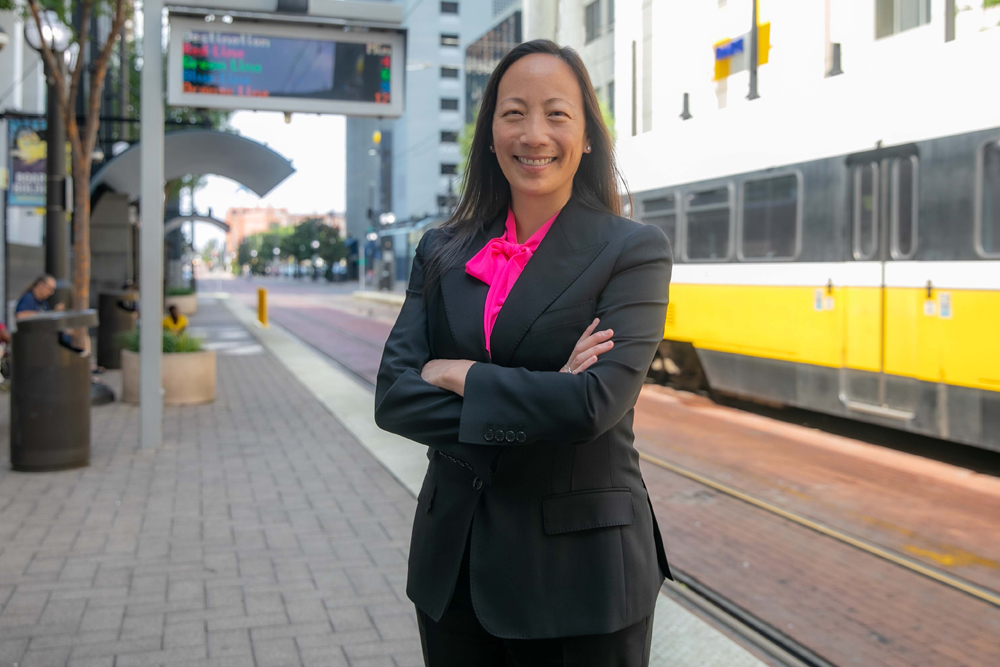The Trains Interview: Nadine Lee, Dallas Area Rapid Transit CEO
Nadine Lee, CEO of Dallas Area Rapid Transit (DART)
Nadine Lee took up her seat as President and CEO of Dallas Area Rapid Transit on July 12, 2021. She brings 30 years of experience in local transportation, most recently as Chief of Staff at the Los Angeles County Metropolitan Transportation Authority (LA Metro). Before that, she was Deputy Chief Innovation Officer, where she developed the agency’s “Vision 28” plan [see “LA Metro to prepare for 2028 Olympics with 11 rail projects,” Trains News Wire, Feb. 21, 2019]. She also served as a project manager for the Denver Regional Transportation District and holds a degree in civil engineering. This interview with Trains has been edited and compressed for the sake of clarity.
Q: How were your first few months at DART?
A: The people were just very nice, very hospitable. The whiteboard [of Directors] It’s been great to hold my hand at all of these different meet and greet meetings we have with the 13 member cities, meet the mayors and city managers, and just hear people’s problems. So it was really exciting to think about how forward-thinking everyone is.
Q: The pandemic has affected the fare revenues of most transportation systems. How are DART finances today?
A: DART is in an excellent financial position thanks to some aid that we have received from the federal government. That has enabled us to spend some money on the things that make a difference for the customer.
Q: What do you see as your top priorities as a CEO?
A: I came here primarily to improve the driving experience. It creates a system that was designed for people. Transit should be easy for you to use. It should be easy for you to figure out how to use transit.
We want your trip to be free of delays and obstacles. We want our system to welcome you. It should be safe. You should feel safe. You should have all the information you need either on the station or on your device. If we can really improve customer journeys, we will improve passenger numbers.
Q: Like Los Angeles, Dallas is an auto-centered city. How do you get people out of their cars and back to DART?
A: The traditional hub and spoke system we developed was for people who traditionally commute from 9 to 5. What we are seeing now is that the curve in travel demand has flattened out at peak times and has actually gotten a little higher at lunchtime and sometimes evenings. We may not have the same travel demand for the longer journeys from the suburbs to the city center, but that doesn’t mean we don’t need the rail system. It just means we need to add lots of great bus connections to it.
Q: However, you continue to build rails. What is the status of the Silver Line project and the D2 subway?
A: The silver line [see “Dallas Area Rapid Transit awards contracts to build Cotton Belt commuter line,” News Wire, Dec. 26, 2018] is a 26 mile corridor from DFW [airport] to Shiloh Road in Plano. It’s a really important part of our network. We originally hoped to open in 2022 and now plan to open in 2024. It’s not a good story to say we’re running late, but the reality is that our building environment is much tougher. We’re just trying to put all the little things away. I am confident that a lot of things will be done in January.
In the subway D2 [see “Digest: Dallas council approves light rail subway project,” News Wire, March 25, 2021], we are approaching some agreements on an alignment at the east end. We worked with [Deep Ellum and the city of Dallas] develop some alternative orientations that better suit their needs. We have submitted a package to the FTA with an application for admission to engineering, which will resume our procedure for the procurement of federal funds [and] also try to get back into the core capacity program. And so hopefully the FTA will accept our submission.
Q: You have been very part of the LA Metro Extraordinary Innovation Bureau [OEI]. What innovations would you like to bring to DART?
A: I just had a briefing about our ideas studio which is very similar to some of the work we did in OEI at Metro. It asks people to come up with ideas to solve a number of our problems. There will be an evaluation process and we will respond to the people who give us these ideas so we can close the circle with them. We’ll be very clear that we want to prioritize ideas that will solve the problems we’re facing right now. We are preparing to start this likely in the first quarter of next year.
Q: What do you love about this job?
A: We’re at a great time, a turning point for DART as we’ve spent a lot of time building much of the infrastructure on the rail side. We have the longest light rail system in the country. There is just an enormous amount of optimism in the churches. It’s a new era for DART, and part of my job is bringing everyone together and trying to do something great for our entire system.
[ad_1]


